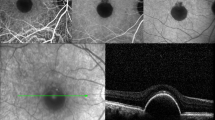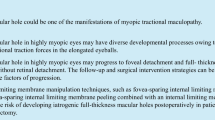Abstract
Purpose
To clarify the characteristics and outcomes of unusual retinal pigment epithelial detachments (PEDs). These PEDs had one or several sites of apparent thinning of the RPE, or no RPE at all, as shown on optical coherence tomography (OCT).
Methods
Eight cases with PEDs showed apparent thinning of the RPE in the roof of the PED at one or more sites on OCT. Color fundus photographs, fundus examination records, fluorescein angiograms (FAs) and/or indocyanine green angiograms (ICGAs), obtained with simultaneous OCT using Spectralis®, and fundus autofluorescence were evaluated. Macular findings, prior to baseline PED detection, were investigated in three cases. Follow-up results were also reviewed in three cases.
Results
Well-delineated grayish-white lesions at the level of the choroid observed through a hypo- or unpigmented area corresponding to the area of thinning in the RPE on OCT. These lesions showed intense hyperfluorescence due to staining on both FAs and ICGAs as well as hypofluorescence on fundus autofluorescence. In three eyes, smaller PEDs had been observed at the same locations and were thus taken as the baseline PEDs on images obtained 22–94 months before this study. In two of the three eyes followed up for at least 35 months from baseline, the PEDs collapsed, leaving RPE-choriocapillaris atrophy in one eye and RPE tear in the other.
Conclusion
Lesions corresponding to the area of thinning in the RPE on OCT may indicate hypo- or unpigmented RPE, possibly as a result of focal damage due to longstanding PEDs. These PEDs may lead to unexpected complications during long-term follow-up.



Similar content being viewed by others
References
Murphy RP, Yeo JH, Green WR, Patz A. Dehiscences of the pigment epithelium. Trans Am Ophthalmol Soc. 1985;83:63–81.
Green WR, Enger C. Age-related macular degeneration histopathologic studies. The 1992 Lorenz E Zimmerman Lecture. Ophthalmology. 1993;100:1519–35.
Casswell AG, Kohen D, Bird AC. Retinal pigment epithelial detachments in the elderly: classification and outcome. Br J Ophthalmol. 1985;69:397–403.
Yuzawa M, Kawamura A, Yamaguchi C, Shouda M, Shimoji M, Matsui M. Indocyanine green videoangiographic findings in detachment of the retinal pigment epithelium. Ophthalmology. 1995;102:622–9.
Matsumoto Y, Kawamura A, Yuzawa M. Indocyanine angiographic features and clinical course of detachment of retinal pigment epithelium. Rinsho Ganka. 1998;52:1729–33 (in Japanese).
Takahashi K. Optical coherence tomography of detachment and tear of retinal pigment epithelium. Rinsho Ganka. 1998;52:1489–93 (in Japanese).
Shiraki K, Kohno T, Ataka S, Abe K, Inoue K, Miki T. Thinning and small holes at an impending tear of a retinal pigment epithelial detachment. Grafes Arch Clin Exp Ophthalmol. 2001;239:430–6.
Feeny-Burns L, Berman ER, Rothman H. Lipofuscin of human retinal pigment epithelium. Am J Ophthalmol. 1980;90:783–91.
Delori FC, Dorey CK, Staurenghi G, Arend O, Goger DG, Weiter JJ. In vivo fluorescence of the ocular fundus exhibits retinal pigment epithelium lipofuscin characteristics. Invest Ophthalmol Vis Sci. 1995;36:718–29.
von Rückmann A, Fitzke FW, Bird AC. Distribution of fundus autofluorescence with a scanning laser ophthalmoscope. Br J Ophthalmol. 1995;79:407–12.
Schmitz-Valckenberg S, Holz FG, Bird AC, Spaide RF. Fundus autofluorescence imaging: review and perspectives. Retina. 2008;28:385–409.
Goldstein BG, Pavan PR. “Blow-outs” in the retinal pigment epithelium. Br J Ophthalmol. 1987;71:676–81.
Kishi S, Tso MO, Hayreh SS. Fundus lesions in malignant hypertension. I. A pathologic study of experimental hypertensive choroidopathy. Arch Ophthalmol. 1985;103:1189–97.
Acknowledgments
This study was funded in part by the Research Committee on Chorioretinal Degeneration and Optic Atrophy, The Ministry of Health, Labour and Welfare of Japan.
Conflicts of interest
S. Notani, None; R. Mori, None; M. Yuzawa, None; A. Kawamura, None.
Author information
Authors and Affiliations
Corresponding author
About this article
Cite this article
Notani, S., Mori, R., Yuzawa, M. et al. Retinal pigment epithelial detachment associated with retinal pigment epithelium thinning revealed by optical coherence tomography. Jpn J Ophthalmol 59, 305–311 (2015). https://doi.org/10.1007/s10384-015-0391-3
Received:
Accepted:
Published:
Issue Date:
DOI: https://doi.org/10.1007/s10384-015-0391-3




